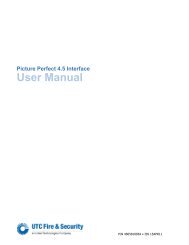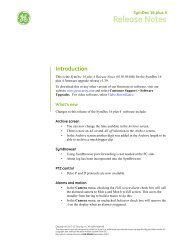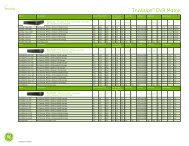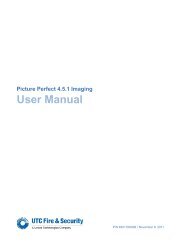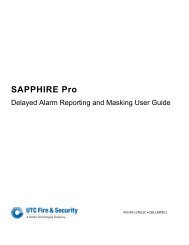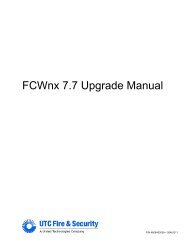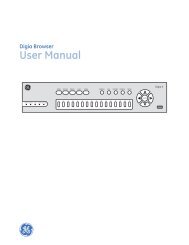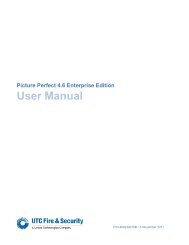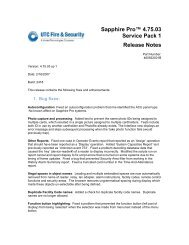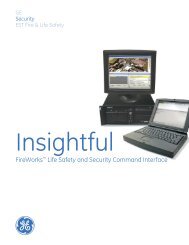Sensitivity Test1. Hold the magnet on the hinge side of the unit for more thanone second (see Figure 7). The LED will flash 1 to 9 times.2. Count the number of LED flashes, then use the followingtable to determine if any action is necessary.Flashes0-1 Indication: Unservicable hardware fault.Action: Reset and rerun sensitivity test. If theerror persists, replace unit.2-3 Indication: Unit is becoming insensitive.Action: Clean and reset the unit. Rerunsensitivity test. If the error persists,replace the unit.4-7 Indication: Unit is within normal sensitivity range.Action: N/A8-9 Indication: Unit is becoming too sensitive.Action: Verify the optical chamber is snappeddown securely. Clean the unit andreplace the optical chamber.optical block chamberindentationsnap into indentationLEDSQUEEZE HEREFigure 6. Detector Maintenanceoptical baseAfter the sequence of flashes, if the sensitivity is within limitsand all other tests pass, the unit goes into alarm until reset bythe panel. If the sensitivity is not within limits, or an unserviceablehardware fault is detected, the alarm LED will continue toflash once per second until the unit is reset by the panel.NoteCSRH models auto reset.magnetMaintenanceThe smoke detectors are designed for easy field service andmaintenance. If a detector drifts beyond its approved sensitivityrange for more than 24 hours, or fails internal diagnostic tests, theunit automatically indicates trouble by flashing its LED everysecond. This meets field sensitivity testing requirements withoutthe need for external meters.NoteConnect to a power supply that will not automaticallyreset. Since the self-diagnostics only indicate troubleafter 27 hours, if the power supply automatically resetsevery 24 hours the self-diagnostic indication will neverbe signaled (the smoke detector will still signal alarmcorrectly).In accordance with NFPA 72, smoke detector sensitivity shouldbe checked within one year after installation and every alternateyear thereafter, in commercial installations, or every three years inresidential sites. See Sensitivity Test.The detector’s replaceable optical block chamber unsnaps for easyfield cleaning and service. Whenever the status LED indicatescleaning is necessary, follow these steps:Figure 7. Sensitivity TestingApprovalsThe smoke detectors are for use in commercial fire protectivesignaling systems and in household fire warning systems(NFPA 72).<strong>429</strong>/<strong>449</strong> <strong>Series</strong>Listed by Underwriter’s Laboratories; California State FireMarshal approved (Listed # 7272-0447-128); MEA approved(New York City) (Listed # MEA 64-94-E) Factory Mutualapproved.1. Open the detector cover, unsnap and throw away the opticalblock chamber. See Figure 6.2. Thoroughly blow off the optical base and snap a new opticalblock chamber (part #211) back in place.NoteBe sure the new optical block chamber is seated all theway down.3. Close the detector cover and verify sensitivity. See SensitivityTest.4 <strong>ESL</strong> <strong>429</strong>/<strong>449</strong>
Planning for EmergenciesDevelop a plan to prepare for emergency situations. Discuss andrehearse your plan with everyone by doing a fire drill every fewmonths.WARNINGDo not enter a building where sirens are soundingGuidelines• Understand how to use your fire system.• Know the normal state of doors and windows: open, closed, orlocked.• Escape fast! (Do not stop to pack.)• Use a different escape route if closed doors feel hot to thetouch.• Crawl and hold your breath as much as possible to help reducesmoke inhalation during your escape.• Meet at a designated outdoor location.• Emphasize that no one should return to the premises if there isa fire.• Notify the fire department from a phone in another building.Your Floor PlanWhen establishing your escape routes, consider the followingguidelines:• Have a drawing for each building level.• Show all exits (two exits per room are recommended).• Show the location of stairwells and fire escapes.• Show the location of all components of the fire system.• Show the locations of all fire extinguishers, hoses, ladders, etc.WARNINGSmoke detectors CANNOT provide warnings forfires resulting from explosions, smoking in bed orother furniture, ignition of flammable liquids,vapors and gases, children playing with matches orlighters.Warning! Limitations of SmokeDetectorsSmoke detectors are very reliable, but may not work under allconditions. No smoke detector provides total protection of life orproperty. Smoke detectors are not a substitute for life insurance.Unreliable transmission or receiving of radio frequency(RF) signals may occur if the system is not installed,located, serviced and repaired properly. RF signals sent by thisdetector may be blocked or reflected by metal objects. Adjacentdevices or systems using radio frequency signals may interfere withthe operation of this alarm. Test the system often to be sure thatsignals are being sent and received properly.Smoke detectors may not be heard. A sound sleeper orsomeone who has taken drugs or alcohol may not awaken if thedetector is installed outside a bedroom. Closed or partially closeddoors and distance can block sound. This detector is not designedfor the hearing impaired.Smoke detectors may not always activate and providewarning early enough. Smoke detectors only activate whenenough smoke reaches the detector. If a fire starts in a chimney,wall, roof, on the other side of closed doors, or on a different levelof the property enough smoke may not reach the detector for it toalarm.Limited Warranty<strong>ESL</strong> is a brand of GE Security. The manufacturer warrants thissmoke detector to be free from defects in material and workmanshipunder conditions of normal use for a term of 3 years from thedate of manufacture.During the warranty period, if a GE Security product or any of itscomponents becomes defective, it will be repaired or replacedwithout charge.Out-of-warranty units will be repaired at the discretion of themanufacturer or, if not, a card will be forwarded to the customersuggesting a replacement unit and the cost of that unit.This warranty does not apply to units which have been subject toabuse, misuse, negligence or accident, or to which any modifications,alterations or repairs have been made or attempted.This warranty is extended only to the original purchaser of thesmoke detector and may be enforced only by such person. Duringthe warranty period, if the detector or any warranted componentsthereof becomes defective, it will be replaced or repaired withoutcharge at the manufacturer’s discretion if returned in accordancewith the following instructions:Obtain a Return Authorization Number by calling 1-800-648-7422or 503-692-4052, then carefully pack the detector in a well paddedand insulated carton and return, postal charges prepaid to:Customer Service RMA#GE Security12345 SW Leveton DriveTualatin, OR 97062-9938A note should be included advising the nature of the malfunction.Care must be exercised in the proper packing of detectors returnedunder this warranty as GE Security will not be responsible forwarranty repairs to equipment damaged because of improperpacking.The above warranty is in lieu of all other express warranties,and implied warranties of merchantability and fitnessfor a particular purpose are limited in duration for a periodof THREE years from the date of manufacture. Under nocircumstances shall manufacturer be liable to the purchaseror any other person for incidental or consequentialdamages of any nature, including without limitationdamages for personal injury or damages to property, andhowever occasioned, whether alleged as resulting frombreach of warranty by manufacturer, the negligence ofmanufacturer or otherwise. Manufacturer’s liability willin no event exceed the purchase price of the product. Somestates do not allow limitations on how long an impliedwarranty lasts, or the exclusion or limitation of incidentalor consequential damages, so the above limitations andexclusions may not apply to you. Unless a longer period isrequired by applicable law, any action against manufacturerin connection with this smoke detector must becommenced within one year after the cause of action hasoccurred.No agent, employee or representative of the Manufacturer nor anyother person is authorized to modify this warranty in any respect.Repair or replacement as stated above is the exclusive remedy ofthe purchase hereunder. This warranty gives you specific legalrights and you also have other rights which vary from state tostate.Smoke detectors are a significant help in reducing loss,injury and even death. However, no matter how good adetection device is, nothing works perfectly under everycircumstance and we must warn you that you cannot expecta smoke detector to ensure that you will never suffer anydamage or injury.<strong>ESL</strong> <strong>429</strong>/<strong>449</strong>5



